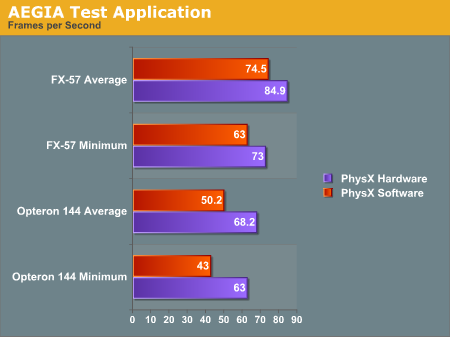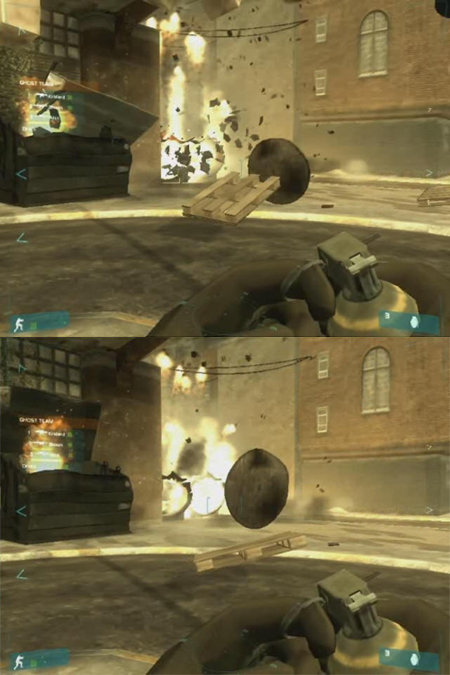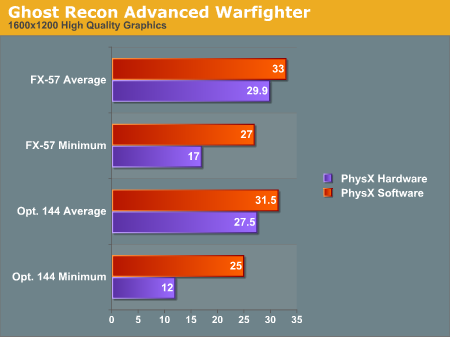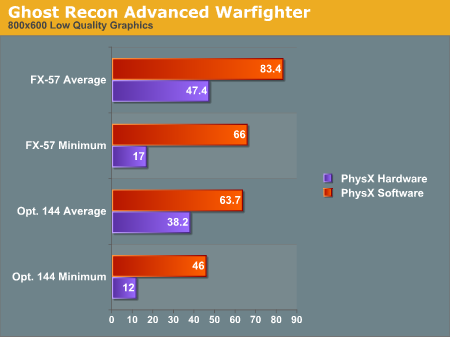Exclusive: ASUS Debuts AGEIA PhysX Hardware
by Derek Wilson on May 5, 2006 3:00 AM EST- Posted in
- GPUs
PhysX Performance
The first program we tested is AGEIA's test application. It's a small scene with a pyramid of boxes stacked up. The only thing it does is shoot a ball at the boxes. We used FRAPS to get the framerate of the test app with and without hardware support.
With the hardware, we were able to get a better minimum and average framerate after shooting the boxes. Obviously this case is a little contrived. The scene is only CPU limited with no fancy graphics going on to clutter up the GPU: just a bunch of solid colored boxes bouncing around after being shaken up a bit. Clearly the PhysX hardware is able to take the burden off the CPU when physics calculations are the only bottleneck in performance. This is to be expected, and doing the same amount of work will give higher performance under PhysX hardware, but we still don't have any idea of how much more the hardware will really allow.
Maybe in the future AGEIA will give us the ability to increase the number of boxes. For now, we get 16% higher minimum frame rates and 14% higher average frame rates by using be AGEIA PhysX card over just the FX-57 CPU. Honestly, that's a little underwhelming, considering that the AGEIA test application ought to be providing more of a best case scenario.
Moving to the slower Opteron 144 processor, the PhysX card does seem to be a bit more helpful. Average frame rates are up 36% and minimum frame rates are up 47%. The problem is, the target audience of the PhysX card is far more likely to have a high-end processor than a low-end "chump" processor -- or at the very least, they would have an overclocked Opteron/Athlon 64.
Let's take a look at Ghost Recon and see if the story changes any.
Ghost Recon Advanced Warfighter
This next test will be a bit different. Rather than testing the same level of physics with hardware and software, we are only able to test the software at a low physics level and the hardware at a high physics level. We haven't been able to find any way to enable hardware quality physics without the board, nor have we discovered how to enable lower quality physics effects with the board installed. These numbers are still useful as they reflect what people will actually see.
For this test, we looked at a low quality setting (800x600 with low quality textures and no AF) and a high quality setting (1600x1200 with high quality textures and 8x AF). We recorded both the minimum and the average framerate. Here are a couple screenshots with (top) and without (bottom) PhysX, along with the results:



The graphs show some interesting results. We see a lower framerate in all cases when using the PhysX hardware. As we said before, installing the hardware automatically enables higher quality physics. We can't get a good idea of how much better the PhysX hardware would perform than the CPU, but we can see a couple facts very clearly.
Looking at the average framerate comparisons shows us that when the game is GPU limited there is relatively little impact for enabling the higher quality physics. This is the most likely case we'll see in the near term, as the only people buying PhysX hardware initially will probably also be buying high end graphics solutions and pushing them to their limit. The lower end CPU does still have a relatively large impact on minimum frame rates, however, so the PPU doesn't appear to be offloading a lot of work from the CPU core.
The average framerates under low quality graphics settings (i.e. shifting the bottleneck from the GPU to another part of the system) shows that high quality physics has a large impact on performance behind the scenes. The game has either become limited by the PhysX card itself or by the CPU, depending on how much extra physics is going on and where different aspects of the game are being processed. It's very likely this is a more of a bottleneck on the PhysX hardware, as the difference between the 1.8 and 2.6 GHz CPU with PhysX is less than the difference between the two CPUs using software PhysX calculations.
If we shift our focus to the minimum framerates, we notice that when physics is accelerated by hardware our minimum framerate is very low at 17 frames per second regardless of the graphical quality - 12 FPS with the slower CPU. Our test is mostly that of an explosion. We record slightly before and slightly after a grenade blowing up some scenery, and the minimum framerate happens right after the explosion goes off.
Our working theory is that when the explosion starts, the debris that goes flying everywhere needs to be created on the fly. This can either be done on the CPU, on the PhysX card, or in both places depending on exactly how the situation is handled by the software. It seems most likely that the slowdown is the cost of instancing all these objects on the PhysX card and then moving them back and forth over the PCI bus and eventually to the GPU. It would certainly be interesting to see if a faster connection for the PhysX card - like PCIe X1 - could smooth things out, but that will have to wait for a future generation of the hardware most likely.
We don't feel the drop in frame rates really affects playability as it's only a couple frames with lower framerates (and the framerate isn't low enough to really "feel" the stutter). However, we'll leave it to the reader to judge whether the quality gain is worth the performance loss. In order to help in that endeavor, we are providing two short videos (3.3MB Zip) of the benchmark sequence with and without hardware acceleration. Enjoy!
One final note is that judging by the average and minimum frame rates, the quality of the physics calculations running on the CPU is substantially lower than it needs to be, at least with a fast processor. Another way of putting it is that the high quality physics may be a little too high quality right now. The reason we say this is that our frame rates are lower -- both minimum and average rates -- when using the PPU. Ideally, we want better physics quality at equal or higher frame rates. Having more objects on screen at once isn't bad, but we would definitely like to have some control over the amount of additional objects.










101 Comments
View All Comments
Clauzii - Monday, May 8, 2006 - link
Youre right.. have to wait and see what happens whith drivers/PCIe then...Hypernova - Friday, May 5, 2006 - link
They should have waited for cellfactor's release as a launch line up for aegia. First impression is important and the glued on approach of GRAW is nothing but negative publicity for aegia. Not everyone knows that physx was nothing more of a patched addon to havok in GRAW and will think that this is how the cards will turn out.If you can't do it right then don't do it at all. GRAW's implementation was a complete failure, even for a first generation product.
segagenesis - Friday, May 5, 2006 - link
As much as I would want to give them the benefit of the doubt... With what you say its that simple really. Most gamers (at least ones I know?) want worry free performance, and if spending extra money on hardware results in worse performance then this product will be short lived.I watched the non-game PhysX demos and they looked really damn cool, but they really should have worked on making a PCI-E version from the start... boards with PCI slots are already becoming dated, and those that have 16x slots for graphics have at least the small 1x slot!
nullpointerus - Friday, May 5, 2006 - link
I wouldn't say it was a complete failure. IMO the benchmarks were quite disappointing, and this was compounded by the lack of effects configurability in the game, but the videos were quite compelling. If you look at the dumpster (?), you can see that not only does the lid blow off but it bends and crumples. If we see more than just canned animations in better games (Cell Factor?), then this $300 should be worth its cost to high-end gamers. I'd say Aegia is off to a rough start, not an implosion.DerekWilson - Friday, May 5, 2006 - link
There are quite a few other things PhysX does in the game as well -- though they all are kinda "tacked on" as well. You noticed the lid of the dumpster which only pops open undersoftware. In hardware it is a seperate object that can go flying around depending on the explosion. The same is true of car doors and other similar parts -- under software they'll just pop open, but with hardware they go flying if hit right.It is also interesting to add that the explosions and such are scripted under software, but much of it becomes physically simulated under hardware. While this fact is kinda interesting, it really doesn't matter to the gamer in this title. But for other games that make more extensive use of the hardware, it could be quite useful.
nullpointerus - Friday, May 5, 2006 - link
That should be very cool. I was playing F.E.A.R. recently and decided to rake my SMG over a bunch of glass panes in an "office" level. Initially, it looked and sounded good because I have the settings cranked up reasonably high, but then I noticed all the glass panes were breaking in exactly the same way. Rather disappointing...DigitalFreak - Friday, May 5, 2006 - link
... may use the Gamebryo engine, but it uses Havok for physics.Bull Dog - Friday, May 5, 2006 - link
You are correct and I noticed that the first time I read the article.DerekWilson - Friday, May 5, 2006 - link
Sorry if what I said wasn't clear enough -- I'll add that Oblivion uses Havok.peternelson - Friday, May 5, 2006 - link
In your introduction you might have mentioned there are TWO partners for bringing this technology to market: Asus and BFG Tech.
Both have shipping boards. I wonder if they perform identically or if there is some difference.
I agree that PCI could be a bottleneck, but I'm more concerned that putting a lot of traffic on the pci bus will impair my OTHER pci devices.
PCIE x1 would have been much more sensible. I hope that they won't need a respin to add pcie functionality but fear this may be the case.
I agree Cellfactor looks more heavy use of physics so may make the difference with/without PPU more noticeable/measurable.
I also wonder how much the memory size on the Physx board matters? Maybe a second gen board could double that to 256. I'm also interested in whether PPU could be given some abstraction layer and programmed to do non-physics useful calculations as is being done on graphics cards now. This might speed its adoption.
I agree with the post that in volume, this kind of chip could find its way onto 3d graphics cards for gaming. As BFG make GPU cards, they might move that direction.